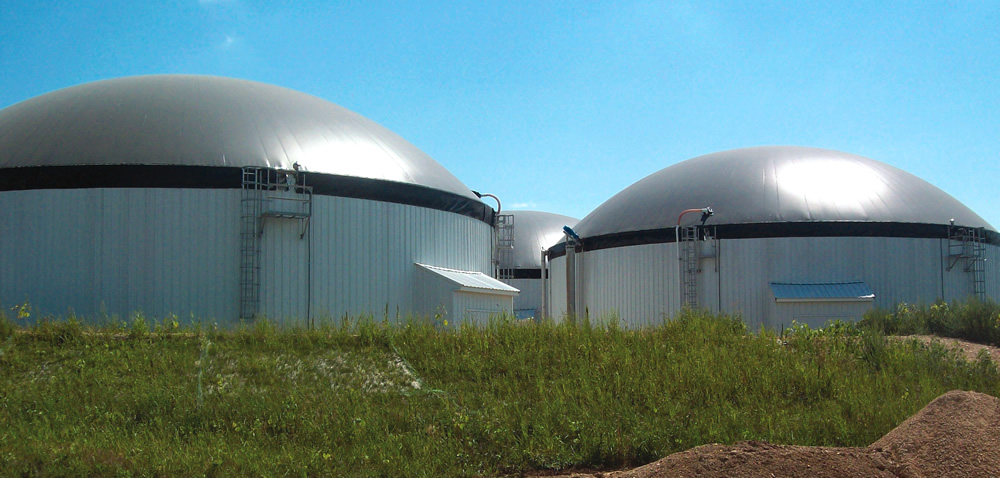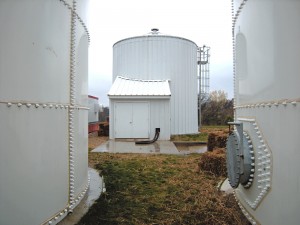Green energy, job creation, dairy manure management and environmental protection all factor in to community digester in Dane County, Wisconsin.
Dan Sullivan
BioCycle February 2012, Vol. 53, No. 2, p. 31
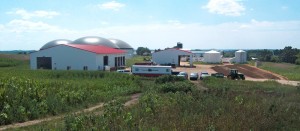
Impetus for the Dane County community digester was a series of fish kills in the Yahara Lakes Watershed in 2005 due to nutrient runoff from dairies.
Falk was first elected to office in 1997 following nearly 20 years as an environmental attorney. “I was elected and reelected because of common shared values with constituents to protect our natural resources,” Falk told BioCycle a day after announcing her second bid for governor of the Dairy State. “We love our farmlands and we love our lakes and streams, and we want them to continue be the best that they can be over the next century.” What galvanized efforts to build a community digester — a project fed by multiple smaller farms as opposed to one big one — was a series of fish kills in the pristine Yahara Lakes watershed in 2005 linked to nutrient runoff from dairies.
Phosphorus was the main culprit “We enlisted a multitude of responses including working with farmers to regulate winter spreading of manure,” Falk recalls. “We have more than 2,300 farms in Dane County and 400 of them are dairies.”
Agriculture as a whole brings about $3 billion annually to the local economy, she says, with dairy making up about a quarter of that. “It’s a three-quarter billion dollar industry, it’s an important industry and it’s part of the quality of life in Dane County.” One of the biggest obstacles to its growth is manure management. (Some Dane County soils currently carry 10 times the optimal phosphorus load of 30 to 40 ppm, while 60 percent of the county’s wells also exceed nitrogen standards.)
“The second current of facts going on was we have these fabulous lakes and streams that have been hurt over many years by nonpoint pollution and in particular phosphorus runoff from farms,” Falk continues. “I am the biggest champion and fan of our farmers, and they are the first ones who don’t want to see our lakes and streams hurt.” A third factor was the need for green energy — reducing reliance on coal-fired power plants and looking at biomass and other renewable energy sources. “A fourth was creating good-paying jobs,” she adds. Following formation of a task force and research into a number of technologies to meet the county’s multiple goals of agricultural viability and sustainability, water quality protection and economic feasibility, the answer to all of these challenges turned out to be a digester that would serve a cluster of smaller farms.
“The community digester was founded on the principle that while we have a few CAFO-type facilities in Dane County, we have many more small and medium-sized farms in this particular watershed,” says Dane County’s Director of Policy and Program Development Dave Merritt, hired by Falk in January 2009. “It is cost-prohibitive for smaller farms to build a digester on their own.”
A big challenge was in finding a cluster of farms in close enough proximity to a suitable site for the project. “We began a survey of the 400 dairy farms to see who was interested — and where we could get the best bang for the buck in reducing phosphorus,” explains Falk. “The three farms that stood up were absolutely heroic and deserve a huge amount of credit. It took a lot of work and conversations in milking parlors, in kitchens and in county offices. It was the first time for a community digester, so there was really no model to look at to see how it was going to work.”
Other pieces of the complex puzzle were negotiating a favorable arrangement with the local utility, Alliant Energy, and ownership and maintenance. Following a request for proposals, Clear Horizons, LLC (a subsidiary of Milwaukee-based Pieper Electric Company), was selected as the owner-builder.
Bolstered by $3.3 million in state funding to mitigate phosphorus pollution — and Clear Horizons covering the balance of the $12 million project (minus the portion funded through a 1603 Treasury grant) — the first community digester went on line north of Waunakee, Wisconsin, in the Town of Vienna, in mid-February 2011 (locally, the project is referred to as the “Waunakee digester.”). By April 2011, the 2 MW facility served by 2,500 cows was generating enough electricity, with an annual dollar value of approximately $2 million, to power 2,500 homes. “I like to think of it as one cow per home,” quips Merritt. Additionally, the county passed a resolution allowing Clear Horizons’ use of $6 million of Midwestern Disaster Area Bonds, effectively lowering the company’s interest rate on incurred debt to finance the project.
Turning Problems Into Solutions
Dane County (population 488,000-plus) is Wisconsin’s second largest county. About half the population lives in the capital city and county seat of Madison. The county is also home to about 50,000 dairy cows collectively producing more than 2 billion pounds of manure annually.
“Manure isn’t something people talk about every day,” says Falk, whose successful campaign for a fourth term included a pledge to see the community digester project through. “What I did was to talk publicly about the challenges dairy farmers face and the need to keep phosphorus out of our lakes and streams. I explained what a manure digester was and how it could be part of the solution. One of my major reasons for running was to get the manure digester built — that’s not your typical platform. But bringing about solutions is what I love doing. We have, 365 days a year, a renewable, reliable energy source, and we’re not going to run out of it any time soon. The future looks very bright for manure digesters.”
A firm commitment on the county’s part was also central. “An important aspect of all this is that Dane County has poured hours and hours of staff time into facilitating these arrangements,” says Falk’s elected successor as Dane County Executive, Joe Parisi, who is championing a second community digester project in Middleton, Wisconsin. “I would encourage other counties in other parts of the country to do the same.” Parisi says a county can serve the critical function of identifying the right players and bringing them all to the table. “County government is in a unique position to facilitate these projects and help them get off the ground.”
Dane County Recycling Manager and digester project manager John Welch concurs. “The developer wasn’t going to spend $100,000 on a feasibility study to find out if there were enough farmers interested, and the farmers weren’t going to spend money and time,” he explains. “The second part to it was to make the permitting and approval process go as smoothly as possible.” Toward that end the county was able to capitalize on good relationships with local zoning authorities, the farmers, the Wisconsin Department of Natural Resources (DNR) and other key players, adds Welch.
The second digester project will be shared by three farms initially, with manure from a combined 2,000 cows producing $1.3 million worth of electricity annually. That project also received $3.3 million in funding authorized by the State Building Commission and will be developed by U.S. Biogas, LLC. Ownership and management terms of that project were still being negotiated at press time. Both projects are designed for future expansion. For instance, in Wanaukee there are three digester tanks, Merritt explains, with potential for expansion, including the possibility of adding a fourth digester, to accommodate any other farms in the area that might want to ship or pump manure to the project.
A fourth farm is considering joining the digester project in Middleton, where the plan is to take in pre and postconsumer food waste from outlets including grocery stores, restaurants and the public. For its combined investment of $6.6 million, the state and county are maintaining residual ownership of both projects. “If the company goes belly up in a year and says ‘this project didn’t work out,’ the state can come in and take back the equipment that it paid for,” explains Welch.
Kevin Connors is director of Dane County Land & Water Resources, a soil and water conservation district that falls under the jurisdiction of county government. Included in that department are land conservation, lakes and watersheds, parks and land acquisitions. State offices of federal agencies such as USDA NRCS and the Farm Service Agency also operate from the same location. “We’re located in what we call a ‘service center’ comprised of federal and local agencies,” explains Connors. “It means one-stop shopping for farmers … It boils down to providing good, consistent and uniform delivery of services.”
Connors, whose agency has been instrumental in facilitating the community digester projects, says there has been definite interest from dairies across the region in participating in similar projects moving forward. “When we did the first feasibility study, we focused on an area of the county with large numbers of animals and issues with phosphorus from manure ending up in our lakes,” he recalls. “After that first feasibility study, we met with other groups of farmers who asked, ‘How come we were not involved?’ We explained that we had to start someplace …We had to do a proof positive.”
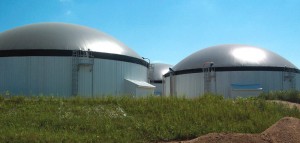
Raw manure from the farms is pumped to the tank on the left, and then is added to one of three 1.25 million gallon digester tanks (below). The tank on the right stores centrate (digested effluent) that is pumped back to the farms.
Monetizing The “Wins”
Connors remains cautiously optimistic the projects under way will have broader implications — and applications. “We have to be able to monetize the wins … being able to take what some people think of as a waste and turn it into a higher value with water quality improvements, direct benefit to the community with local energy … and higher utilization of phosphorus and fiber as part of this process. There are a lot of benefits that could be borne by more than just an individual farmer. We need to think about how this can be supported by the greater community, including utilities.” Toward that end, Welch and Connors suggest mechanisms such as sustained tariffs and leveling the playing field for biogas among other renewables in order to ensure the economic viability of these projects.
“The technology has come a long ways,” says Welch. “You can’t point to it anymore as being recent. Now it really comes down to financials. If there’s money to be made, it will get built.”
Biogas projects need the same types of incentives and subsidies currently in place for other forms of renewables such as wind and solar, and even for some domestically extracted fossil fuels, he adds. “You can level the playing field through policy.” Welch suggests that states’ renewable energy portfolios could go a little further in guaranteeing project paybacks and standardizing agreements with utilities for connection fees. “Right now you can tell utilities they have to pay 12 cents a kWh, and they can come back and say ‘fine, it’s going to cost you $2 million to interconnect,’ so you need to standardize that side as well.”
Additionally, says Connors, customers might be willing to pay a premium to support the lifestyle they desire. “That’s part of the economics of this … It gets back to quality of life of the community that benefits from having agriculture. From my standpoint, it’s a win-win on many different fronts. Manure always happens, that’s a fact; as far as a resource, it’s pretty reliable.”
Public-Private Partnerships
One model that has given legs to the Dane County digesters, and to other AD projects across the country, is the concept of public-private partnerships. “It definitely does complicate the arrangement — including more parties sometimes doesn’t simplify things,” says Clear Horizons’ Biogas Operations Supervisor Monte Lamer. “It’s cumbersome in a way, but there are benefits, too, such as shared costs and shared risks.”
Like others involved in the project, Lamer pointed to the utility companies as a potential weak link that may require creative and persistent prodding to get on board. “We need to bend their arms a little bit,” he says. “We are buying power from these companies, and they need to support energy projects that have community benefits, such as minimizing nutrient pollution in the waterways.” It can be a tough sell in a down economy when already existing mega power plants are operating well below capacity, due in no small part to a slowdown in the manufacturing sector.
He adds that renewable energy projects require the long view. “Maybe our governors and senators need to impress upon the utilities that they need to become active in supporting these projects. The efficiencies, if you are using the waste heat, are night and day compared to a coal-fired power plant that doesn’t use the waste heat and it all goes up the stack.” The bottom line, he says, is that the power needs to be purchased at a fair price that considers externalities, in order to justify the cost of building the digesters. “The logical source is the power companies, which do not typically support the technology, although they may give it lip service.”
Another option, says Lamer, would be to utilize the biogas as truck fuel. “The cost of this fuel is 35 percent of the present cost of diesel fuel,” he says. “The problem is you need a fleet or a dozen trucks to make the economics work. Sweden’s truck fleet is 50 percent fueled with biogas. In the U.S., Waste Management fuels 1,000 trucks on biogas produced from their landfill gas, so, you see, it all doesn’t need to be converted to electricity.”
Merritt recalls a visit in 2009 by USDA Secretary of Agriculture Tom Vilsack to Ripp’s Dairy Valley Farm, one of the three farms recruited for the initial project. “Secretary Vilsack is a major proponent of building digesters,” says Merritt. “The Secretary and [dairy farmer] Chuck Ripp had an important meeting of the minds.” Like all farmers involved in the two projects, the Ripps receive the multiple benefits of nutrient management — the liquid manure is pumped underground via pipes from each farm to one of three 1.25 million gallon digester tanks, and the liquid portion of the digestate is pumped back to each farm for field application . Per a mandate from the state DNR, all solid digestate not utilized by the participating dairy farmers for livestock bedding must be exported out of the watershed. A Centrisys centrifuge with a phosphorus removal system captures more than 60 percent of the phosphorus in the digested manure. The phosphorus attaches to (or mixes in with) the separated solids.
Each farm has three lines with auto valves controlled via SCADA (supervisory control and data acquisition), explains Lamer. “Clear Horizons control engineers have developed a software program that automatically pulls the manure to and from the farm pits — depending on level and volume — 4 to 12 times a day. The manure comes through one pipe, but there is a second line for an emergency, or, if there is an obstruction in one, we can use the spare line while we are working on the other.” From the pipe, the manure is stored in a 90,000-gallon tank used as a collection basin for feeding the digesters. The third line is the centrate, (return) line that transports the manure “tea” back to the farms’ lagoons where it is stored for later use as a fertilizer.
Clear Horizons is working to optimize the centrifuge and phosphorus removal system. ”There are not many centrifuges used in North America to remove phosphorus, so we are learning many things,” says Lamer. “The centrifuge is very good at removing the fiber but with our high solids content, it does get plugged from time to time. We are looking into some design changes to solve this.” A dryer for the digestate also required attention early on. “We are assembling a new dryer to replace the original dryer that failed,” he adds. It is expected to be operational soon.
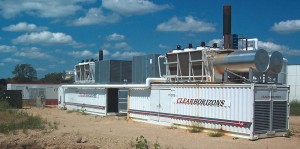
Alliant Energy pays Clear Horizon, the digester owner and operator, an average of 9.25 cents/kWh for the power it produces from its CHP system (above).
Undeterred By Lack Of Funding
While some federal incentive programs for AD have dried up, (e.g., Section 1603 U.S. Treasury Department grants) Merritt says Dane County and the state will not be deterred. “Some say expiration of the 1603 cash grants will set back renewable energy development. We’re ready to move ahead, though. We are already taking a look at [community] digester three.”
As for state-initiated policies and incentives that could or have had a positive impact, Merritt, Parisi and Falk all point to Wisconsin’s pioneering Renewable Portfolio Standard (RPS). The first state to enact such a standard without having restructured its electric-utility industry, Wisconsin’s 1999 RPS originally required investor-owned utilities and electric cooperatives to obtain at least 2.2 percent of the electricity sold to customers from renewable energy resources by 2012. Subsequent legislation enacted in 2006 increased renewable energy requirements and established an overall statewide renewable energy goal of 10 percent by December 31, 2015. (Wisconsin currently leads the nation in the number of on-farm digesters.) RPSs are used it as a tool for enhanced tariffs, explains Merritt. “Specific to the Waunakee project, Alliant is paying Clear Horizons an average of 9.25 cents per kWh for the power it produces.” At peak load, the utility pays 12 cents/kWh.
Adds County Executive Parisi: “It demonstrates that renewable energy portfolio requirements do have a positive impact on the economy and help make these types of projects viable. These emerging sectors of our economy need a little boost to get going.” Not only do the community digester projects help manage multiple environmental problems, he says, they bolster the local economy. “Think about how we import $850 million worth of coal — a nonrenewable resource — from out of state; there certainly isn’t any of it in Wisconsin. Now think of the benefit of that $850 million if it was staying in the state and fueling renewable energy projects such as these. We need to keep pressure on government to continue to look at renewable energy and in particular locally produced renewable energy. We’ve got to get legislators to increase those renewable energy standards. We need to keep pushing.”
If elected governor, Falk says she’ll do just that. “As governor, I’d like to do more digester projects,” she says, referencing “a laundry list of efforts state government can and should be making to help farmers and utilities work together.” Finding new solutions to old problems takes time and patience and homework, she adds, but the rewards are tremendous. Falk and other project partners have also expressed hope the community digesters will serve as examples of local solutions to local problems and as models for similar projects across the Upper Midwest and throughout the country. “This is technology and energy that can be produced right here in Wisconsin,” Falk says, “and it means clear lakes, more jobs, green energy and a thriving dairy industry.”


